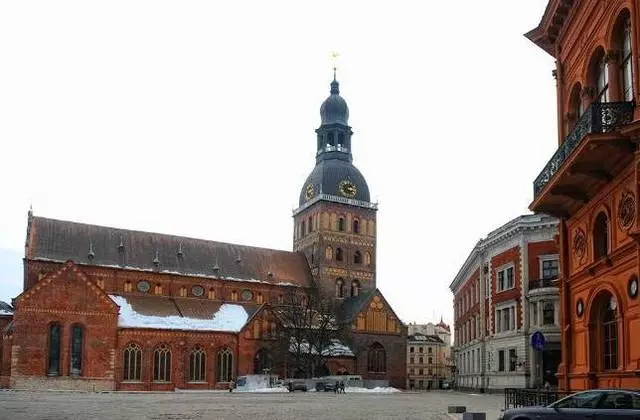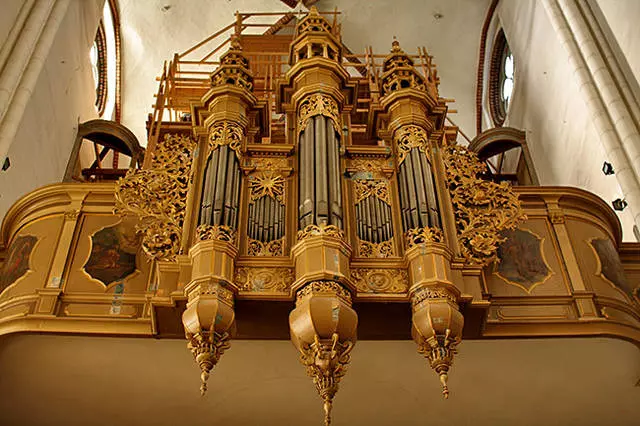If you are in Riga, then, of course, the city center visit certainly. Personally, I highlight about a dozen monuments of history and architecture in this city, but I can say for sure, it is possible with great difficulty. Exclusively for the reason that Riga actually has one big monument! Of course, there are iconic places and they are not only for tourists. Today it will be a cathedral that you will see on the souvenir symbolism of Riga with a probability of 99%, this is the heart of the city, The Dome Cathedral And naturally Doma Square.
The Dome Cathedral is, first of all, a symbol of spiritual life and, perhaps, not only Latvia, but also the Baltic States as a whole and only then the monument. Rigane is very preferable to him, believers from all over the world come to listen to the concert programs of the famous organ of the Dome Cathedral, this is a place in which millions of people open their heart to God.

The Dome Cathedral is the stronghold of Lutherhood, but for the awareness of his greatness and beauty, it does not matter to which denomination you belong.
You can order an excursion and consult about the time of work and holding concerts by phone +371 67227573. As a rule, worships take place on weekdays at eight in the morning, on Sundays at twelve days. The entrance ticket is five lats, excursions are held every day, except Friday. Planning a trip, please note that work is currently being carried out on the restoration of the cathedral and at different times the various parts of it can be closed with construction forests.
This architectural monument is included in the UNESCO World Universal Heritage List and, accordingly, is protected not only by the laws of Latvia. But here it should be noted that the practical every cobblestone bridge has the same status.
It is best if your way on the excursion will start with the northern side of the Dorsion Cathedral, just choose Jauniela's street for a hike, she is in the past "New Street", her novelty has roots in the XVI century, since those even times the name has not changed. The length of the street is just 225 meters, but what! Each centimeter of this street is a story! Firstly, it is simply aesthetically pleasant to the eye, real "gingerbread houses" with an abundance of cafes and restaurants (about ten of them if I do not change my memory, that is, one for every 20 meters), in which you can slowly drink a cup of magnificent coffee and eat Breakfast on the way to a long, meaningful and therefore a tedious tours.
Secondly, it was here that several cults for the Soviet viewer of the films were filmed: "17 Moments of Spring" - the unfortunate professor Plaischner fell out of the fourth floor window on the street new, and just opposite the fall and failed turnover could observe the entire honest company Sherlock Holmes, Dr. Watson and Mrs. Hudson, as the same street and there is a famous Baker Street, though the cult door of the owner's apartment is around the corner of the house number 22 on the street is new, but the windows have a very suitable location. Directly opposite the door of the famous house on Baker Street We were lucky to drink coffee at a table in an open cafe. Drinking coffee on Baker Street - I didn't bother about it and think once, but dreams have a property come true!
In one of the houses of this street, I lived in the 18th century Emperor Peter I, and the Queen was born - Powlina Württemberg. Actually, the whole street Jauniela is, in essence, the open-air museum.
Walking along it in it will come to the Dome Cathedral already penetrating the spirit of time and will certainly feel like a little traveler in time.
The Cathedral will send you to the beginning of the XIII century, it is in this temporary gap that begins a countdown of glorious centuries, during which he gives people joy during which he gives people. The name of the Dome Cathedral was allegedly formed from the phrase on the Latin "Domus Dei" ("God's House), he is currently the largest temple of the Baltic countries and is also unique with the fact that he has imagined, probably all architectural styles that changed each other on For centuries (more precisely, a nomochea, early gothic, baroque, Yighdstil) are presented here. The initial building itself lasted quite a long time, then there were fires, wars, and just "Hand of Time" did not gentle the mighty stones ... So he gained those unique features that please our eyes today. Initially, a rather modest building in a laconic romanesque style with basilica, later a century was made to adjustments and the cathedral took the shape of the Hall Temple, the side chapels were added, elongated premises with columns, known today as "Western Nephors". Even the hand of Catherine II reached here, it was her decree that his decree triggered the transfer of the Riga City Cemetery and the burials of the Dome Cathedral, including (in sanitary and epidemiological purposes), and the result was raising the level of gender in the cathedral.
The spire of the tower, which we see today appeared in the middle of the XVIII century and is made in the style of Baroque, it decorates a symbolic "Golden Cockerel" (one of the symbols of the city). If you are at least a little attentive, then the same "bird" will find on the spiers of the Councils of St. Peter and St. Jacob.
Above the portal of the northern entrance, it is also called the "Paradise Potal", the rare sample of Middle Ages is preserved - "Coronation of Mary". And on the stunning beauty of stained-glass windows, the scene of the first stone of the Cathedral, the stained glass windows of the south side, which portrayed the life of Christ was not preserved to the present.
In Soviet times, the Dorsion Cathedral experienced difficult times, in the early 60s it was rebuilt under the concert hall, dismantled the altar and set the chairs, however, it was probably that it allowed him to preserve him from a more sad fate. In the XIX century, an organ was built in the cathedral, to this day, not having analogues in the world, the virtuoso farnz leaf itself wrote works for this great musical instrument.

In the eighties of the 20th century, the body was renovated, interior works were carried out, all engineering communications were renovated, the restoration touched even the famous "Golden Cockerel", the Copper Tower Sheaving, the air conditioning system was created in the hall and in the tower. And some outstanding monuments of the Middle Ages managed to preserve without a substantial intervention of the restructors: carved wooden surfaces of the side panels on the chairs, a gravestone monument of the bishop of Mainard, two benches from the northern and south side (Adam and Eva and Maria Magdalena, respectively).
The performers who are invited with concert programs to the Dome Cathedral are definitely honored with special honor. In the manufacture of this, no analogues, the musical instrument was used pine, maple, oak, beech, pear, spruce (all these tree breeds have a beautiful texture and durable). He has a long list of registers, manuals, pedals and other details, but, confess, I am not strong in the designs of the organs, more details you will learn from the guide. I can only add about it that it became obvious from the first note to us - this is a terrific imagination tool due to the acoustics of the temple fascinates you regardless of religion, nationality, age, and so on ... The impression produces a truly indelible, similar sound in my memory has no One previously heard musical instrument. This monumental sound, he is a monument to himself.
In the 1930s of the XX century, it was decided to "expand" the domestic square adjacent to the Cathedral and some buildings around it were demolished. Now there are numerous fairs, exhibitions and concerts. And in the late 80s of the same century, during archaeological studies, the Cemetery of Kurons or Kurshek (by the way, very militant and rich tribes were found to be found at the Doma Square.
Total about 9,000 square meters, and what is the concentration of historical monuments, interesting details - and, I ask you to notice, we touched on only one of the attractions of this amazing city!
It is literally breathing in history, this is the greatest cultural heritage not only for people whose homeland Amber Sea, but also for citizens of all over the world and compulsory for visiting the place!
